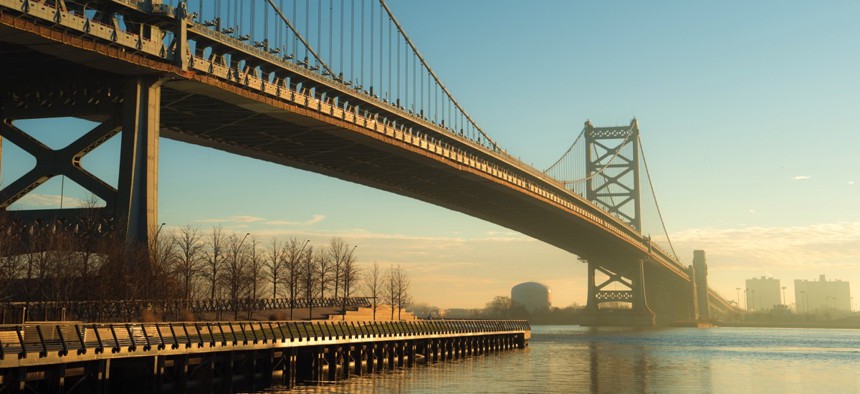Philadelphia Moves to Prepare for a ‘Warmer and Wetter’ Future

Ben Franklin Bridge Boon Chawan / Shutterstock.com

Connecting state and local government leaders
The city issues a new report on climate change, as 21 mayors from around the world sign a pledge in Paris, committing money to resiliency efforts.
Anticipating that climate change will bring hotter temperatures, heavier rain and more snowfall, officials in Philadelphia on Wednesday issued a comprehensive report that attempts to identify ways the city is vulnerable to warmer and wetter weather, and how it can move to become more resilient.
Extreme weather events like heat waves and hurricanes will happen with greater frequency in Philadelphia during the coming years, the report warns, while sea level rise threatens to inundate parts of the city and worsen flooding from the Delaware and the Schuylkill rivers.
The authors identify a range of adverse effects that extreme weather and climate change have the potential to cause. These include more cases of health problems such as heat stroke, overwhelmed stormwater infrastructure, transportation disruptions and power failures.
There are also more mundane findings. For instance, broiling temperatures might force municipal construction workers to shift toward more overnight hours.
Since 2010, Philadelphia has experienced the snowiest winter, the two warmest summers, the wettest day and the two wettest years that have been recorded in the city. There have also been two hurricanes, and a derecho, which is a type of severe windstorm.
“The effects of a changing climate are already apparent in Philadelphia,” Katherine Gajewski, the city’s director of sustainability, said in a statement Wednesday.
“We need to understand what climate change will look like on the ground and how to advance smart, proactive initiatives that will help us to prepare,” she added.
Titled “Growing Stronger: Toward a Climate-Ready Philadelphia,” the newly issued, 80-page report caps off a multi-year planning process orchestrated by the city’s Office of Sustainability, which involved other city departments and agencies.
The report was released as international leaders gathered this week for climate talks in Paris.
On Wednesday, 21 mayors and city leaders from around the world signed a pledge at the talks, committing to dedicate the equivalent of ten percent of their cities’ annual budgets toward “resilience-building” activities. The group that developed the pledge, 100 Resilient Cities, is backed by The Rockefeller Foundation. According to the group, the budget commitments the cities made totaled $5.2 billion.
U.S. cities that signed the pledge included: Berkeley, California; Boulder, Colorado; New Orleans; Norfolk, Virginia; Oakland, California; Pittsburgh; and Tulsa, Oklahoma. Philadelphia was not among the signatories.
"This commitment demonstrates our continued efforts within the city of Pittsburgh to build resilience, and it allows us to think strategically and concretely in regards to our allocation of resources in our budgets," Pittsburgh Mayor Bill Peduto said in a statement.
Within the Philadelphia report are detailed climate projections for the city during the coming decades, as well as an assessment of specific city assets, like buildings and roads, that would be vulnerable to flooding under different scenarios.
With two feet of sea level rise, a scenario the report says is likely to occur by mid-century, Philadelphia International Airport, which is located near the Delaware River, would be exposed to flooding, along with at least a dozen other city facilities.
Among the potential climate-related costs mentioned in the report are those tied to natural disasters, and also increased operating expenses. The city expects up to $1 million in additional electricity costs annually due to the increased demand for air conditioning.
A set of criteria the authors lay out is meant to provide a framework for evaluating the feasibility of actions, or strategies, city departments might take to maintain services and infrastructure as the climate changes. These criteria include capital costs, recurring costs, flexibility, additional benefits—like economic development, or providing green space, and other barriers not captured in the first four criteria, such as political or legal considerations. The criteria are designed so that actions or strategies can be scored based on their current feasibility.
The full report can be found here.
Bill Lucia is a Reporter for Government Executive’s Route Fifty.

NEXT STORY: The Movement to Make Legal Codes More Accessible Expands in Miami





